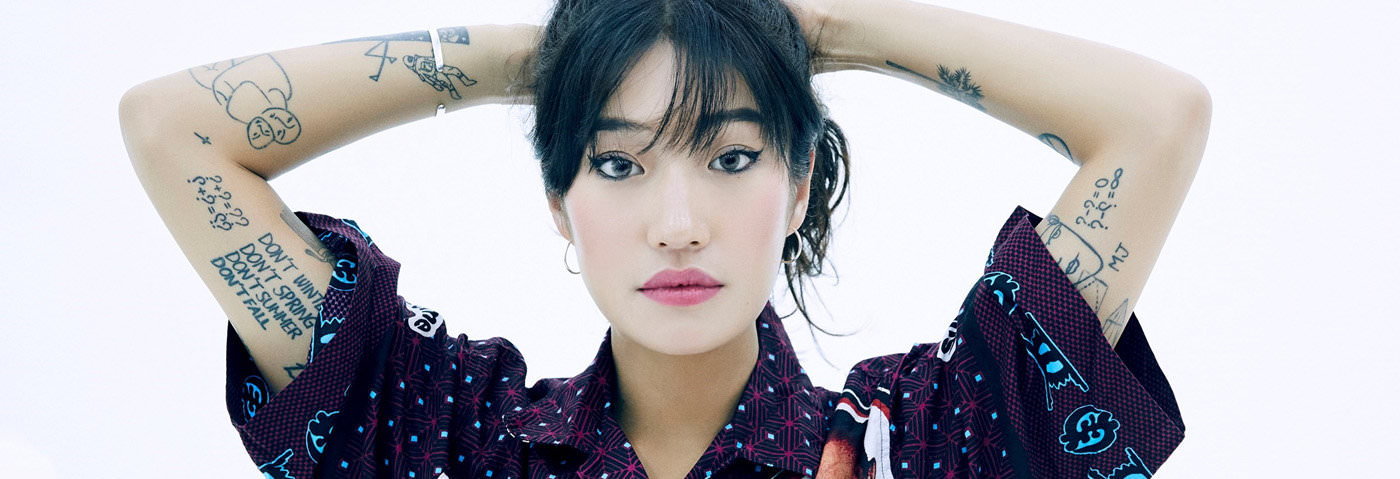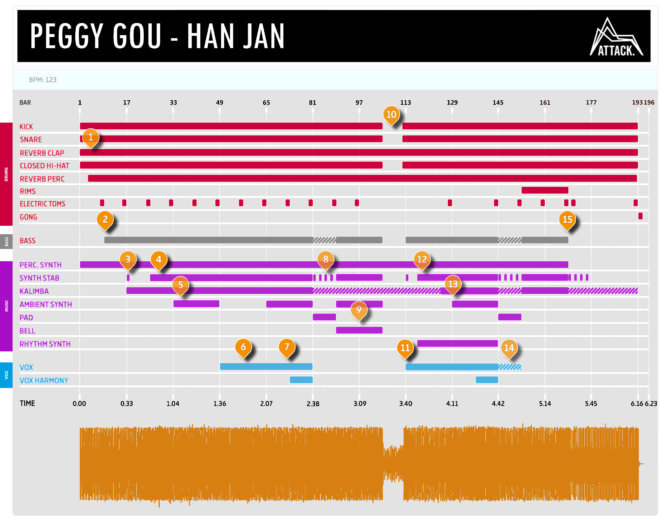In our latest Deconstructed we break down the arrangement of Peggy Gou’s wildly popular ‘Han Jan’.
Peggy Gou burst onto the scene with music as dynamic and eccentric as her character. ‘Han Jan’ is the standout cut from her Once EP, released on Ninja Tune earlier this year. The track wears its influences on its sleeve, apparently inspired by 90s electro from the likes of DMX Krew, Drexciya, and Maurice Fulton plus 80s work by Japanese singer-songwriter and Yellow Magic Orchestra co-founder Haruomi Hosono.
Here’s what makes the arrangement so infectiously catchy…
The Track
THE ARRANGEMENT
online pharmacy https://www.dentists4kids.com/wp-content/uploads/2014/05/ventolin.html no prescription
online pharmacy buy spiriva without prescription with best prices today in the USA
(Click to enlarge.)
WHAT’S HAPPENING?
- The drums kick off the track with a punchy and charismatic rhythm that draws you effortlessly into the record. We immediately hear a round and upfront kick, the fizzy-sounding snare and two different claps sequenced around the snare in order to fill up the space. Some bongos hold the backbone of the rhythm, playing around the kick and filling in the gaps. A sprinkling of 16th-note hi-hats run continuously over the groove, increasing the energy of the track. Each phrase finishes with a very 80s-sounding tom roll. Note how the two claps change in pitch from high to low and feed into the same reverb send. Their different frequencies reveal different clusters of reflections from the virtual reverb room.
- A funky bassline appears at this point, with the sound carefully chosen so as not to be too dominant in the low frequencies, allowing it to sit almost like a lead line. Its retro sound helps it fit perfectly with the already vintage-sounding drums.
- New elements are introduced via a chord stab which sounds almost like a horn, filling up some of the background space. The stabs are placed at the back of the mix using reverb. A subtle delay also adds rhythm and makes the melody appear more complicated.
- The brassy chord stab that we heard earlier now develops in rhythm and melody, appearing more frequently. More delay is added to the plucks with automation, helping build tension to the end of the phrase and drawing the listener’s attention to what will happen next.
- We hear a new filtered melody which feels an octave lower than the plucks. This slow, aquatic melody is swimming in reverb to ensure that it remains in the back of the mix. It also adds vital variation to the fairly repetitive beat. This pattern repeats for 16 bars, with the drums remaining constant throughout, establishing the groove and feel of the track.
- The underwater melody departs, replaced by Peggy’s own vocal in her native Korean. To non-Korean speakers, her choice of language adds a level of curiosity to what she may be saying. At bar 53 we hear the first “han jan” (한잔, “a drink”) and the rapped verse changes rhythm. The vocal has a radio effect EQ and a very short slapback-style delay (around 100ms) which prevents it from feeling too poppy or overwhelming.
- Here Peggy breaks into what feels like the chorus of the track, switching from rapping to singing and from Korean to English. The singalong-friendly lyrics are supported by the aquatic melody we heard earlier in the track. At bar 73, the chorus develops with a higher harmony tucked behind the already-mesmerising vocal.
- The vocals drop out and are followed by a change in bassline rhythm and a new, ominous-sounding chord progression which anticipates the upcoming section. The brass chord stands and the plucks play at the beginning of every two bars, reminding us of what the record might break back into.
- The arrangement returns to its original bassline and brass chord sequence, plus a new bell synth sitting prominently on top. The melody of this new bell synth develops up until bar 105.
- The main drums (kick, snare and hats) are pulled out of the mix for the breakdown, giving the listeners a moment without any low end. The bongos, plucks, reverbed claps and brass stabs continue, holding this section together. The next section is signalled with a big drum roll including toms, hats and the kick.
- The full drums and bassline return, alongside Peggy’s rap. At bar 117, a new synth is added, playing high up in the register and panned to the right. Unique elements such as this help to maintain variation and progression throughout the track as all too often, avoiding the possibility that things might get too repetitive.
- The floaty panned synth continues, as does the rap. The brass stabs are reintroduced, underscoring the funky groove.
- Peggy goes all in here, adding the aquatic synth and the plucks alongside the floaty synth. Her vocal changes once more from spoken to sung for another chorus.
- For a brief four-bar interlude, Peggy breaks up her vocal and tails off her words with a 1/4-note triplet delay. She also reintroduces the same ominous chords we heard at bar 81, before swiftly switching back to the melodies and rhythms we heard at the very beginning of the track, signalling the arrival of the outro.
- The bassline ends abruptly and the beat is broken down into the drums, plucks (without the delay) and some light, reverbed hits which are panned left and right, accentuating the stereo field. The brass chords still play up to bar 177 but eventually break off. The track ends with its signature drum roll, one of the defining elements of the arrangement.
buy cialis-soft online cialis-soft online no prescription
online pharmacy order glucophage online with best prices today in the USA
buy https://magview.com/wp-content/uploads/dlm_uploads/2019/04/super-kamagra.html online https://magview.com/wp-content/uploads/dlm_uploads/2019/04/super-kamagra.html no prescription pharmacy


09.23 PM
Thank you. Peggy’s a legend in the making.